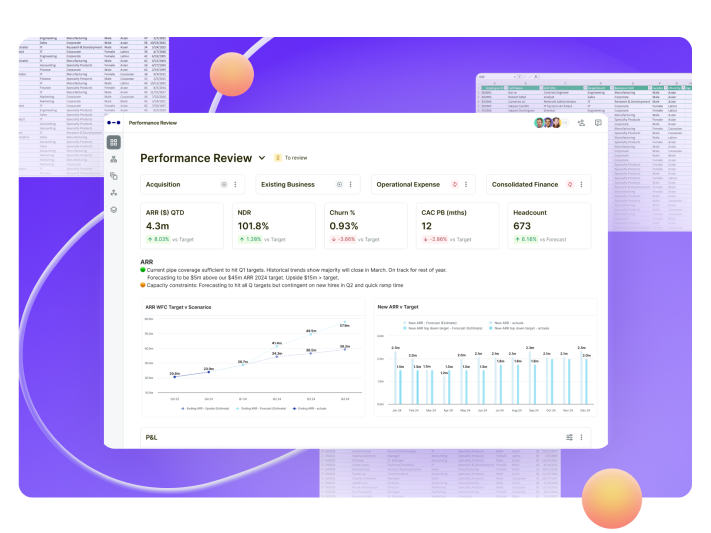
FP&A Approved: Profit and Loss (P&L) Statement Template
Learn more ->
Before your business turns a profit, it reaches a point where the revenue coming in covers business expenses. With the right break-even analysis template, you can find that point with ease and increased accuracy.


Although break-even analytics aren’t always part of the monthly process, FP&A teams can use this template regularly to analyze new product release numbers, find the right pricing mix, and understand the impact of certain investments on business performance. Break-even analysis is a basic calculation in theory, but it is also one of the most informative pieces of supplemental information for FP&A teams and other business leaders.
Content created by: María Asín Portell, FP&A Ops Senior Associate at Abacum
When you were creating a business plan at the very start of your venture, it’s likely that investors and banks regularly asked you to provide a break-even analysis. Identifying your break-even point is critical in the early days of business because it showcases the exact junction where your revenue from sales is equal to the costs associated with doing business – both fixed and variable costs.
For small businesses and mid-market companies alike, the break-even point provides a realistic target for when the organization can expect profitability. While many industries target a 6-month to 18-month break-even point, others may be a bit longer. In any new venture or startup, this break-even analysis template turns a frequent, time-consuming analytical task into something that can be done in minutes.
Be careful not to fall into the trap of thinking that a break-even analysis template only works for small businesses that are just starting out; this metric is constantly updated and reevaluated by mid-market and large businesses, too. When rolling out a new product, the sales team needs to understand the break-even point to determine sales targets. If HR wants to hire new employees, FP&A teams need to understand where the point of profitability sits and how to maintain that even with added expenses.
If finance leaders don’t have a deep understanding of the break-even constraints they need to manage, then your business could dip below the line of profitability, lose investor funding, and even be forced to close down shop.
Don’t worry, getting a handle on break-even analytics is insanely simple with our break-even analysis template; let us show you how to make the most out of the custom template within Abacum. Abacum’s custom break-even analysis template seamlessly integrates with your business systems, including, ERPs, HRIS, BI tools, CRMs, spreadsheets, data lakes, and other data sources. Through this integration, your FP&A team can construct an accurate template that works every time.
Break-even analysis looks at total revenue, total variable costs, and total fixed costs to determine the sales volume required to cover costs entirely. It does not delve into profitability, but rather, highlights exactly when an organization can expect to switch from negative to positive returns.
With advanced financial modeling, break-even analytical capabilities are more advanced than they have been in the past. The end result is the number of units needed to reach an equilibrium between the inflow of revenue and the outflow of costs. Now, companies can get out of clunky Excel templates and move to automated, detailed break-even analysis templates that provide a better look into all the variables that lead to the end result.
Break-even analysis is sometimes considered a simple business calculation, but in reality, if an organization wants it to be accurate, it requires detailed tracking, reporting, and financial modeling. Something that seems as small as testing a new marketing campaign can lead to changes in both revenue and costs, completely changing the result of the equation.
There are multiple ways to think about your break-even point; sometimes teams are trying to solve for the number of units that they need to sell in order to break even, others analyze the product price needed to break even, and even further, you might be attempting to understand how long it takes to break even.
The starting formula for break-even analytics is as follows:
Break-Even Point = Fixed Costs / (Price – Variable Costs)
Where:
With Abacum, no matter what you’re trying to figure out in relation to your break-even point, our system allows you to test different scenarios, understand the marketing funnel associated with product sales, and even adjust cost levers or expected incoming revenue based on certain business decisions such as a strategic campaign or major sale.
At all stages of doing business, monitoring your contribution margin, fixed costs, variable costs, and break-even point will provide valuable insights and information. There are many scenarios when detailed analytics around these metrics come in handy, such as:
Relevant in many settings, break-even analysis can be done in simple Excel sheets or in more detailed, complex systems that have advanced capabilities. Today, to get an accurate look into your break-even point, we recommend moving away from, or at least supplementing manual Excel macros with next-generation software like Abacum.
With Abacum, you don’t have to get rid of your existing Excel worksheets or Google Sheets calculations; instead, our software effortlessly links with all your existing systems, pulls data from multiple sources, and creates a consolidated, final view with actionable insights, detailed visuals, and scenario testing features.
End-to-end, a good break-even analysis encompasses many business functions and considers a number of factors. Starting with your sales funnel, your business can get an idea of how much revenue will come in based on a number of different metrics. With Abacum, we seamlessly track and display many important metrics, so you know you’re getting the information you need every time.
Depending on your business, some of these line items may include:
Of course, with each of these items, businesses can click into the transaction-level detail behind them, revealing the supporting data. Abacum pulls the information from your ERPs, CRMs, and other systems, ensuring all summary views are cohesive and accurate.
Having a strong understanding of your sales funnel leads directly to better revenue predictions, improved spending management, and the best business results. Getting a read on your break-even point starts with sales and marketing, even if the formula doesn’t showcase them directly.
If a business owner needs to adjust their break-even point, one of the most effective ways to do so is by reducing costs associated with the curation of the goods or services their business offers to its customers. Considering total fixed costs and total variable costs can shed light on areas of opportunity to cut spending, but this process also illustrates which costs should be increased due to their impact on sales, and therefore, revenue.
Fixed costs can be a bit more difficult to adjust because they include things like the office space lease and business insurance. Although these costs are critical to doing business, the cost-per-unit actually goes down when production shoots up.
Total variable costs, on the other hand, fluctuate with production levels. If you make more units, you’re going to spend more on direct labor, raw materials, and shipping. Finding bulk discounts with suppliers, hiring the right people at the right price, and optimizing certain processes are all ways to reduce variable costs.
As FP&A professionals ourselves, the team at Abacum knows just how integral apps like Microsoft Excel and Google Sheets are in business today. For decades, these tools have paved the way when it comes to financial analytics, with VBA code, macros, and other advanced features changing our finance teams operated many years ago.
We don’t expect these tools to go away or leave finance ecosystems entirely, but in today’s reality, they should funnel into software tools, like Abacum, with more processing power and better analytical capabilities. Abacum can easily connect with your existing business systems, including more traditional business platforms like Excel.
With tools that are more manual, like Excel and Google Sheets, updating a file with multiple calculations can take a devastating amount of time away from value-add activities. Something that seems as simple as downloading raw data, inputting it into the file, and refreshing the file for a new month can end up taking hours depending on the size of the data set and the complexity of the file. Adopting a tool that does that all automatically pays dividends by saving your employees time when they need it most.
Abacum’s offerings when it comes to overall revenue management, sales funnel management, cost adjustments, and break-even analytics is unparalleled by other products on the market. We built a holistic, comprehensive tool that allows users to slice and dice data from nearly-endless sources until their business picture is complete.
We’re committed to helping you usher in a new era of financial analytics; everything from marketing campaign tracking to break-even analysis to sales reporting can be done in Abacum. When cross-functional collaboration is as easy as it is with our platform, every strategic business plan on the table becomes easier to reach and exceed.
When using Abacum, preparing a break-even analysis template goes from being a clunky, manual process to a streamlined, often automated undertaking. All you need to do is make adjustments to system mappings, ensure all the necessary financial data is being processed in the template, and, voila, your break-even analysis template will populate automatically.
The formula for an organization’s break-even point is: Break-Even Point = Fixed Costs / (Price – Variable Costs). Use this to factor in all the funds that are coming in from the sale of your goods or services, along with the costs incurred in production and business operations, and you’ll be able to understand your break-even point.
Break-even analysis highlights the exact point that your business expects to cover all costs with revenue. In theory, any sales made beyond the break-even point indicate positive revenue numbers and a healthy business.
This metric is utilized throughout the life of a business; new product releases, startup funding rounds, and so much more lean on break-even analysis to paint a complete financial picture.
If you’re in the business planning stage, it can be challenging to figure out the numbers behind sales funnels and operating costs, but it can be done. Use industry estimates to get an approximate picture that is as accurate as possible.
In your business plan, directly call out all the inputs you are using for each component of this analysis to show the legitimacy of your calculation.
Although Excel doesn’t have a built-in break-even analysis template, it is possible to build your own within the tool. Or, if you prefer, some websites offer free downloads of existing templates that can be utilized within Excel. To skip the hassle altogether, using a SaaS solution such as Abacum can bypass time-consuming template building and allow your FP&A team to get straight to analytics, business partnering, and advancing your organization’s financial goals.
